Description
Microsoft 365-based email accounts for OHIO students, faculty, staff, and alumni who graduated after 2000.
Access
Who can access
-
Current applicants, employees, and retirees
-
Enrolled undergraduate and graduate students
-
Emeriti and alumni who graduated after 2000
-
Sponsored guest accounts
How to request access
Features
Connect with other applications
Platform Needed
-
PC and Mac
-
Mobile Applications
Additional resources
Service support
Get help
- Visit the Technology Help Center ( help.ohio.edu
) to get live support, view outages, and browse trainings.
Accessibility
Visit the following Microsoft support page for information about accessibility features available in Email:
Ohio University strives to make its digital resources and services accessible to all visitors, including those with disabilities who may also be using assistive technology. If special steps are necessary in order to improve the accessibility of experiences for end-users, those steps must be taken.
If you experience a barrier that affects your ability to access OHIO websites, videos, online forums, documents, or other information technology, please let us know
.
For further information about OHIO's digital accessibility resources, see:
Security
Security Features: Catmail
Catmail includes advanced security features to protect you and the University from phishing scams, malware, and accidental disclosure of sensitive data.
Advanced Threat Protection
External Sender Warning
When you receive an email from an external sender (anyone outside of ohio.edu), the email will include a yellow banner at the top, warning you to use extra caution when clicking links or opening attachments. The warning is designed to reduce phishing attacks,
which are fraudulent emails, often designed to look like official University communication, that trick users into disclosing sensitive information or opening attachments that install malicious software.
Reporting Phishing
When you receive a suspicious email, you can report it as a potential phishing attack directly from your email application. Reported phishing and junk messages are sent to both to OIT and Microsoft, where they are reviewed to improve the effectiveness of spam filters.
Catmail (Outlook on the Web) users can report suspicious emails using the “Junk” dropdown menu and selecting “Phishing”:
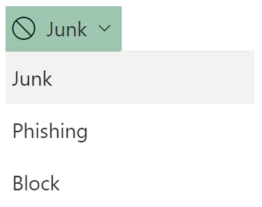
Outlook desktop users will find a “Report Message” button in the Outlook Ribbon at the top of the screen:

To report suspicious emails on Outlook for iOS, iPadOS, or Android, tap the three small dots in the upper right corner and tap the “Report Message” icon:
| iOS: |
Android: |
| 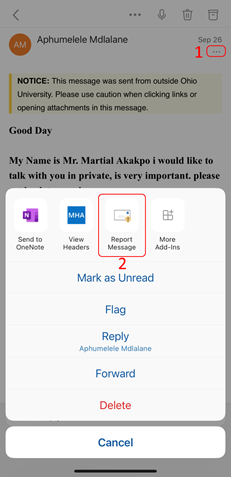
|
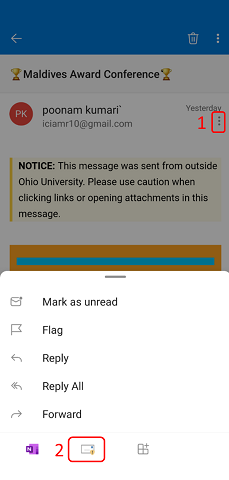
|
SafeLinks
When you click a link in an email message, SafeLinks
uses an automated Microsoft service to verify that the link's destination is not malicious. If the link appears to be malicious, the service will display a warning and prevent the linked site from loading. If you are using Outlook, you can view the actual destination of a SafeLink by mousing over it. If this does not work, or if you are checking your mail from a non-standard email client, you can use our SafeLinks decoder (OHIO login required)
to view a link's destination.
Safe Attachments
When someone sends you an attachment, Safe Attachments
will scan that message and attachment using machine learning and analysis techniques to detect malicious content. Delivery may be delayed a few minutes to allow this scanning to occur. If a malicious attachment is detected, the attachment will be removed, and a substitute text file named “Malware Alert Text.txt” will appear in its place. If you believe an attachment was removed by error, contact the IT Service Desk
.
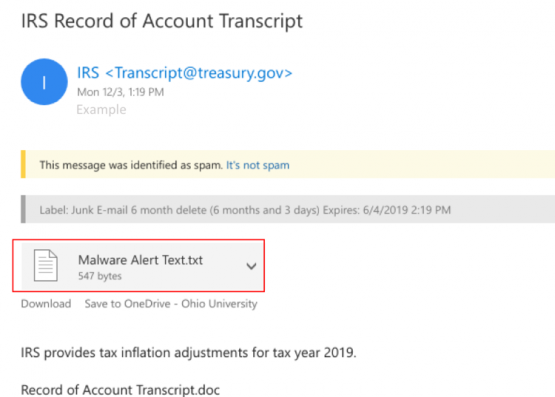
Data Loss Prevention
Email is not a proper method to share sensitive data with external parties. To reduce the likelihood of sensitive data disclosure via email, Ohio University has enabled Microsoft 365 Data Loss Prevention (DLP)
for Catmail. Automated DLP scans can help reduce the risk of distributing sensitive data; however, it is still your responsibility to handle that data appropriately.
Respecting privacy - DLP scanning is automated. An Information Security analyst will only access a copy of a message if DLP flags that message as containing a large amount of sensitive data.
What to expect: Social Security numbers
If DLP detects one or more Social Security numbers in an outgoing email, the service will block that message and notify the sender of the issue, either with a Policy Tip or through a rejection message.
In Outlook on the Web or Outlook for Windows, a Policy Tip will appear at the top of your window letting you know that your message appears to contain sensitive data and giving you the option of reporting a 'false positive.' If you press Send, the message will be rejected.
On Outlook for Mac and mobile apps, the Policy Tip will not appear, but the message still will be rejected if you try to send it.
To report a false positive, forward the rejection message to the IT Service Desk
for assistance.
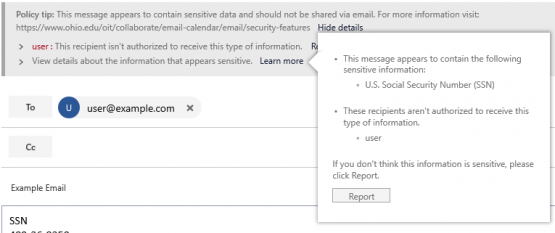
Outlook on the Web

Outlook for Windows

Rejection "bounce" message
What to expect: other sensitive data
-
If DLP detects high volumes of PII (personal identified information) being sent to a non-ohio.edu address, the service will create an incident report for the Information Security Office.
-
A security analyst will review the flagged data to determine if a data loss has occurred.
-
If the match is a false positive, the case will be closed with no further action required.
-
In the case of an actual data loss, normal incident response procedures will be followed, including disciplinary action if needed.
What to do if your message is blocked
If you still require sending sensitive information via email, please encrypt your document
prior to sending it. You can password protect the document and securely share the password with the recipient via another form of communication such as telephone or in-person.
The Ohio University Information Security Office
strives to educate and empower the University community to appropriately manage risks and protect OHIO’s information and systems. This effort is facilitated through policies, standards, and information security risk management programs, as well as other tools and guidance that are provided to the University community. This modern approach creates a safe computing environment in which the university community can teach, learn, and conduct research.
For additional information about OHIO’s security resources, see:
